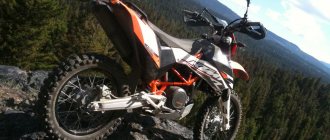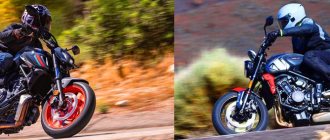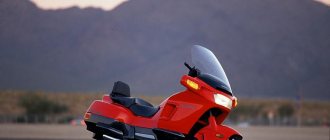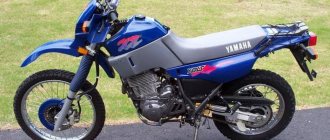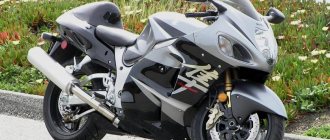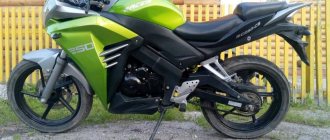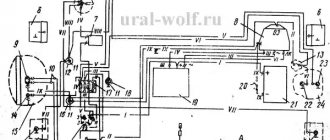We must admit that compared to most of its competitors, the KTM 690 Duke looks like an aristocrat at a party for hard workers from a nearby factory. No, we are not trying to belittle the merits of motorcycles of other brands, in no way, but the difference between the Austrian and the Japanese in this case is visible at first glance. Representatives of the Big Four of Japan rely on a combination of reliability, high technology and relatively affordable prices, but the Austrians simply do the best they can, without caring that not everyone can afford such a beauty as the KTM Duke 690. Worth it This toy is really quite a lot, but one look is enough to fall in love with it. And, most likely, this love is forever.
And it's not just a matter of style. The designers, of course, did their best for the KTM 690 Duke, but not everyone likes the angular appearance of this road bike. The main advantages of this motorcycle are hidden inside, and you understand this immediately as soon as you ride it at least once. It seems that he has been possessed by the devil, who tirelessly whispers in his head: “Come on, unscrew the right handle harder!” Explosive character combined with phenomenal handling, ergonomics thought out to the smallest detail and tenacious brakes that instantly stop the KTM Duke 690 - this is perhaps a short but very succinct description of this motorcycle. In the class of “ six hundred road builders ” he is undoubtedly the most charismatic and extraordinary representative. But the more unusual the motorcycle is, the more it differs from others, the more it is, as they say, “not for everyone.” Let us only note that the majority of motorcyclists who have had the chance to ride a KTM 690 Duke for at least ten minutes quickly fall into the category of such amateurs.
Engine
The power unit was created on the basis of the 690 Duke R, released in 2010. The development was led by Josef Mindlberger, thanks to whom the LC4 received two spark plugs with individual coils, which are controlled independently of each other by the ECU and the Drive-by-Wire throttle control system. Engine output remained unchanged - 70 horsepower and 70 Nm - but fuel consumption and emissions of harmful substances were reduced by almost 10%.
The 690cc engine featured an APTC slipper clutch and balancer shaft and was similar in design to the engine introduced a few years earlier in the Duke 690R and now found in the 690 Enduro-R and 690 SMC-R.
On Saturday I had the chance to take the KTM 690 Duke R for a ride and ride it for about eight hours. Until the impressions fade, I want to share them with the public. So, given: 690 Duke in the R version, or, in our words, DukeR. The curious can see how it differs from the regular Duke on the manufacturer’s website. I noticed the following points: — the engine is 69-something hp/70 Nm (vs. 67 for the Duke); — suspension travel is 150 mm, adjustable front and rear (Duke’s suspension is not adjustable, travel is 135 mm); - jar - Dill; — a cage was installed that fit perfectly into the frame (I didn’t even immediately realize that it was a body kit); - the saddle is higher - 865 mm versus 835 for the Duke with the same ground clearance. The moped that was given to me for execution had stock firmware and a Standard ignition map, and I was strongly asked not to play with the seat spinner, so all further impressions relate to this particular combination. Based on the results, we can say that the DukeR 690 is a very unique unit. The first feature is that it has no low end at all. The four-pot scabies, compared to it, is just a tractor, easily starting from second gear and crawling confidently at idle. The 690 is literally in agony at 2 thousand rpm. Squeezing through a tight traffic jam at a speed of 20-30 km/h is painful for him: in first gear he jerks epileptically following the slightest movement of the throttle, and in second he gasps, trembles, and rattles the chain like the Canterville Ghost. As a result, driving in traffic jams often requires releasing the clutch - fortunately, a very light one. By 3 thousand revolutions it begins to work more or less stably, but spins up very reluctantly. And at 4 thousand it suddenly comes to life and instantly reaches 8 thousand, at which it hits the cutoff. Here the second feature of DukeR is revealed. Typically, a four-stroke engine will deflate slightly at the top of the range, and without looking at the tachometer you feel that it’s time to shift. There is no weakening of acceleration here - from 4 to 8 thousand the 690 accelerates like an electric train, and when it reaches the red zone it simply folds the pantograph. And at first you just freeze in bewilderment: “What, is everything already?” It seems that if the engine’s tolerances allowed it to be turned to higher speeds, it would burn for a long time - but no. In general, you drive like this, constantly keeping the tachometer in the range from 4 to 8. In the city, 6th gear is not needed at all. And the 5th in most cases too. Outside the city, to quickly overtake, you have to drop not one, but two or three stages at once - and then try not to miss the cutoff. At the same time, Mot doesn’t exactly go crazy, but it accelerates very convincingly. There are no problems with overtaking someone. But you have to constantly kick with your left foot. Personally, sitting on the Duke is hellishly uncomfortable for me (I’m 196 cm tall). My legs were bent so that I quickly gave up trying to stand up on uneven surfaces. The saddle is as hard as a board. It doesn’t vibrate like a child; at operating speeds you don’t have to look in the mirrors: the picture turns into an itchy haze. The chassis is awesome. DuqueR is very light, and he turns with the power of thought - you don’t have to do anything with your arms and legs. The suspension, with standard adjustments, is quite stiff, and shakes noticeably at joints and potholes, but it licks the asphalt waves in corners very well, and in general it behaves extremely composedly when taxiing. Tomosas are beautiful. I don't know how they will perform under serious heating, but in normal condition they gradually turn the driver into an impudent person. The duiker is generally a terribly provocative device. Because it’s not interesting to ride it quietly (worse, it’s inconvenient), and it allows you to drive a greyhound in such a way that at some point the illusion of complete impunity appears. In general, the evolution of my attitude towards this spendthrift looked like this. In the first 15 minutes I hated it. I was enraged by the lack of bottoms, by the short tops, I missed the running boards located somewhere near my back pockets, I shied away from cars jumping out of vibrating mirrors - in short, all 33 pleasures and a beaten sirloin to boot. Then, at the very least, I put up with Duquet's choleric disposition and went about my business, wondering, however, how such a combination of inconveniences, mixed in one bottle, could be sold for such money. And an hour later I realized that I was enjoying this toy. When you start to navigate by sound, and you no longer have to constantly stare at the orange arrow, when you get used to actively clicking the gearbox, you begin to simply and unpretentiously drag from the unprecedented lightness combined with constant elastic acceleration, from the wonderful brakes, and again from the lightness, from the feeling of being a driver not a motorcycle, but a witcher's broom - this is such a crap that you can't get enough of it. There are a lot of motorcycles whose engines are more flexible and powerful, which are more comfortable to sit on and load with luggage, and which protect you from wind and splashes. But which one weighs 150 kilograms and is controlled by your gaze? In general, I'm in thought. Considering the height, Duke is not my option. But the 690th motard drills into my brain with terrible force. Worse, I had almost decided that I would take it. So it goes. I hope these observations are useful to someone.
Dashboard
Panels "Film-born" for Mattighofen: born from the Supermoto concept, it was just a motard for racing. Only five years later a class of powerful naked road motorcycles appeared.
Everything changed in 2011, after the management of the KTM plant set a task for the next five years to conquer the road motorcycle market in all available segments. Previously, the brand was positioned as a manufacturer of enduro and cross-country motorcycles, but since 2012 the plant began to produce several new products every year. Today, motorcycles of the Supersport, Naked, Adventure and Sport-Turing classes are produced under the KTM brand.
KTM 690 R Duke motorcycle test
It's a pity. It’s a pity that I didn’t immediately start counting the looks of people passing by, looking in surprise at “my” two-wheeled vehicle. Frankly, at first it just seemed to me that those around me were amused by the disproportion of the massive helmet-wearing guy and the elegantly bright motorcycle. But, looking at the first photos, I thought that most likely they didn’t see me at all. And they look and listen only to him - a white with orange arches, warlike growling beast. KTM 690 R Duke.
Prejudice is a powerful thing. The Austrians have been producing a variety of “supermotards”, “streets” and even sportbikes for more than ten years, but in the minds of even the very two-wheeled enlightened population they remain the kings of off-road, and any piece of equipment from Mattinghofen that is not intended for mixing mud or jumping over it causes genuine surprise. However, KTM marketers and dealers are clearly aware of something similar, otherwise how can they explain the price tag of almost 600 thousand rubles. for a strange-looking “single-barreled gun”?
I admit, I am also full of prejudices, but, unlike the opinions of outside observers, they are of a slightly different nature. For example, I never liked single-cylinder engines, that is, those same “single-barrel engines” from the previous paragraph. It’s also hard for me to understand why you would put a wide all-terrain steering wheel on a device designed to be laid on its side during a “time attack” at a karting track or daily “punching through traffic jams.”
And in general, it’s kind of frivolous - this 690 R Duke. Parrot-like red arcs, the only dial in the instrument cluster of the same color, dull light bulbs...
Okay, down with the grumbling. Called himself milk mushroom - don’t say it’s tasteless. I press the starter button and am immediately surprised: the engine hardly vibrates - thanks to the balancer shaft. However, he is able to overcome only one of the troubles of single-barreled guns, but the other, namely uneven traction, is much more important!
There was no need to worry: the engine with the LC4 index pulls perfectly, with all its 70 forces and such a number of newton meters, which for 149 kilos of dry mass is beyond the eyes. Here it’s worth making a nod towards the electronic throttle and two spark plugs, each of which works according to its own map, optimizing the combustion of the fuel-air mixture.
Meanwhile, my foot is pointlessly pulling up the gear shift lever: is it already sixth? Yes she. It’s a pity, I would add one more: it would be more pleasant to “shoot” straight with it. However, the speedometer already shows an “illegal” speed, fortunately the surface is still smooth.
On the move, the KTM 690 R Duke is frighteningly responsive. I bet an inexperienced rider might mistake the result of shifting the balance on the handlebars for “wobbling” and be scared to death. The Duke is generally demanding when it comes to landing: “falling on the handles” or a shift in the pilot’s center of gravity relative to the optimal over-engine position leads to serious deviations in the behavior of the “motorcycle-rider” system.
After such first impressions, I waited for the meeting with unevenness as if it were a sentence. And again I was wrong: the duker turned out to be extremely patient, the inverted WP fork did not try to knock the wrists out of their joints, and the rear wheel suspended on a monoshocked pendulum did not allow the trajectory to mutate even when driving through very noticeable potholes.
And I have to admit, I got into them with unenviable regularity, and all for one reason: in the saddle of the KTM 690 R Duke, I always rode faster than I originally intended.
It was as if he was pulling me out of the hole of the instinct of self-preservation as bait, encouraging me and goading me: come on, hurry up, everything will work out! And everything really works out. Even with factory suspension settings, which can be changed at your own discretion.
However, this is entertainment for those who like to race on go-kart tracks. For them, the motorcycle is protected on all sides by arches and sliders - even if an overly confident rider carefully comes into contact with the asphalt, nothing fatal will happen. At least with a motorcycle.
But I didn't experiment. And not at all out of fear of damaging the test equipment. And not out of idiosyncrasy towards overalls. Just experimenting with iron and my own body for the sake of freshly mined fractions of a second is not my thing. Well, for those who want to master the circuit driving technique, without wanting to write off the plastic of sports bikes as scrap, the KTM 690 R Duke will be just right. And for the majority - even growth.
Chassis
No significant changes have been made to the chassis design, but it differs from analogues of previous models - the motorcycle’s handling when moving in a straight line has been significantly improved, which was achieved thanks to the increased fork offset in the yokes, which provided a flatter Trail of 99 millimeters. The front wheel is positioned a little further from the centerline of the steering column, which increases stability when driving in a straight line. The motorcycle does not require special repairs: with regular maintenance, it is recommended only to replace the KKTM 690 Duke pads and the opinions of experts and is achieved through more precise tuning of the electrical equipment and installation of a new exhaust system. The R version is also several horsepower more powerful, and the basic version is equipped with all systems - MSC, MTC, MSR and C-ABS. The passenger seat of the version is closed with a special cover, so it is not possible to transport a second person.
Difference in design
Motorcycle owners note their bright appearance, which attracts the attention of everyone in city traffic. One look at the KTM is enough to understand that it is an expensive model. Both models - both 690 and 690R - are almost identical in appearance, but there are certain differences.
The R version's steering wheel is painted black, and the LED turn signals are designed more elegantly than the base model. The 690 R is also equipped with crossbars that indicate the tightening torque of the fixing bolts. Both motorcycles are equipped with WP suspension, but only the Duke R model has adjustable suspension. The Brembo brake caliper caliper is more powerful on the R version. The 690R's sporty riding position is enhanced by higher-mounted footpegs that allow the bike to be tilted while riding.
Total
Many lucky riders who have had the chance to ride the KTM 690 Duke call it the perfect city bike . And there is a considerable amount of truth in this statement! Perhaps not everyone will like the character of this angular and daring Austrian, but the KTM Duke 690 does not try to please everyone at once. Expensive, very demanding on fuel quality and simply non-standard, it is, however, good in all respects. This combination of advantages is rare and for this reason alone the Duke 690 stands out among other motorcycles. And he's good. Really good.
Handling and Driving Feel
For those who have never ridden a motocross bike, the Duke will be a real discovery. The low saddle provides a flat and relaxed riding position, but on the R version it is slightly higher, but even a tall pilot will find it difficult to reach the ground. The motorcycle is narrow, but the handlebars are wide, which, coupled with its low weight, ensures ideal handling. Motorcyclists note that you can maneuver on any city street, even with the densest traffic flow. A separate advantage is the hydraulic clutch drive, which can be pressed with one finger.
KTM Duke motorcycles are memorable for their behavior and riding position. The full potential of the models is revealed in busy city traffic: the 690 and 690R have excellent maneuverability and dynamism. The motorcycle accelerates very well from a standstill, but on the highway it only picks up speed to 160, after which it somehow reaches 200 km/h, then the autopilot actually turns on. The pilot could relax, but the resistance of the headwind prevents this from happening.
On the basic version of the Duke, the brakes are more than enough for an effective and quick stop, and it is almost impossible to overheat them, but on the 690R version there are even more of them: despite the fact that the model is equipped with only one brake disc, the caliper stops the motorcycle sharply, almost completely ignoring the ABS system . The wheel is locked using the rear brake after slightly pressing the pedal.
Video Review
Specifications
| Maximum engine power: | 67 hp (49.2785 kW) HP |
| Working volume: | 690 cm3 |
| Motor type (cylinder arrangement, number of strokes): | 1C - single cylinder, 4-stroke with spark ignition and liquid cooling |
| Number of cylinders: | 1 |
| Number of valves: | |
| Intake type (Injector / Carburetor): | |
| Bore and stroke: | |
| Starting system (Electric starter, kick starter): | |
| Maximum speed in km/h: | 200 km/h |
| Cooling system: | Liquid |
| Transmission (gearbox): | Mechanical 6-speed |
| Clutch (Dry / Wet): | |
| Drive unit: | Chain |
| Frame: | Powder coated chrome steel tubular space frame |
| Chassis | |
| Suspension (front/rear travel): | |
| Brakes (Front/Rear): | |
| Wheels / Tires / Rubber: | |
| Dimensions and weight | |
| Dimensions (Length / Width): | |
| Seat height: | |
| Ground clearance: | |
| Curb weight: | |
| Wheelbase: | 1466 mm |
| Weight: | 149.5 kg |
| Fuel tank capacity: | 14 l. |
| Battery capacity: | |
| Year of release: | |
| Country of Origin: |
Engines
In terms of character and volume, the single-cylinder engine is amazing: motorcycle owners note that this is most clearly noticeable on the 690R, which is equipped with Akrapovic, which almost does not muffle the sound produced by the engine.
The engine revs up very quickly, and the motorcycle responds almost instantly to the throttle. The lower rev range is not particularly pleasing: up to 4-6 thousand, the motorcycle maintains a smooth and confident ride. All the fun begins after crossing the maximum threshold: the Duke easily accelerates to 150 km/h. Gearshifts are crisp and firm, a legacy of off-road models. Between 5th and 6th gears, you can stumble upon a false neutral if you are not confident enough to change gears.
The maximum speed of the Duke 690 is 195-200 km/h and depends on the driving skills of the driver. The engine can hardly be called economical: fuel consumption is 6-7 liters per 100 kilometers.
All options offered on the 690 R version can be installed on the base Duke 690 model by ordering them from an authorized dealer as an additional package. This feature allows you to avoid additional payments for multi-colored rims and arches by tailoring the 690 model to the characteristics of the 690R. There is no need for monobloc Brembos and custom suspension installed on a motorcycle unless the rider goes to the race track.
Pros and cons of the KTM 690 Duke
Advantages
- Low weight . Handling this motorcycle is very easy, unless, of course, you take into account its sharp reaction to turning the throttle.
- Very effective brakes and ABS system.
- Excellent handling at almost any speed, from near zero to maximum.
- Thoughtful ergonomics . All the controls are placed in such a way that the KTM 690 Duke feels comfortable to almost all bikers, regardless of their height and weight.
- The ability to fine -tune the engine “to suit you” using fuel maps.
Flaws
- High price . The KTM Duke 690 costs significantly more than many other motorcycles in the same class. The content also costs a pretty penny.
- Complex design . It is almost impossible to carry out many repair and maintenance procedures on your own, and you have to go to an official dealer, which is expensive and not always convenient.
- is too light , due to which at high speeds there is a certain lack of directional stability.
- Sluggish traction at low speeds.
